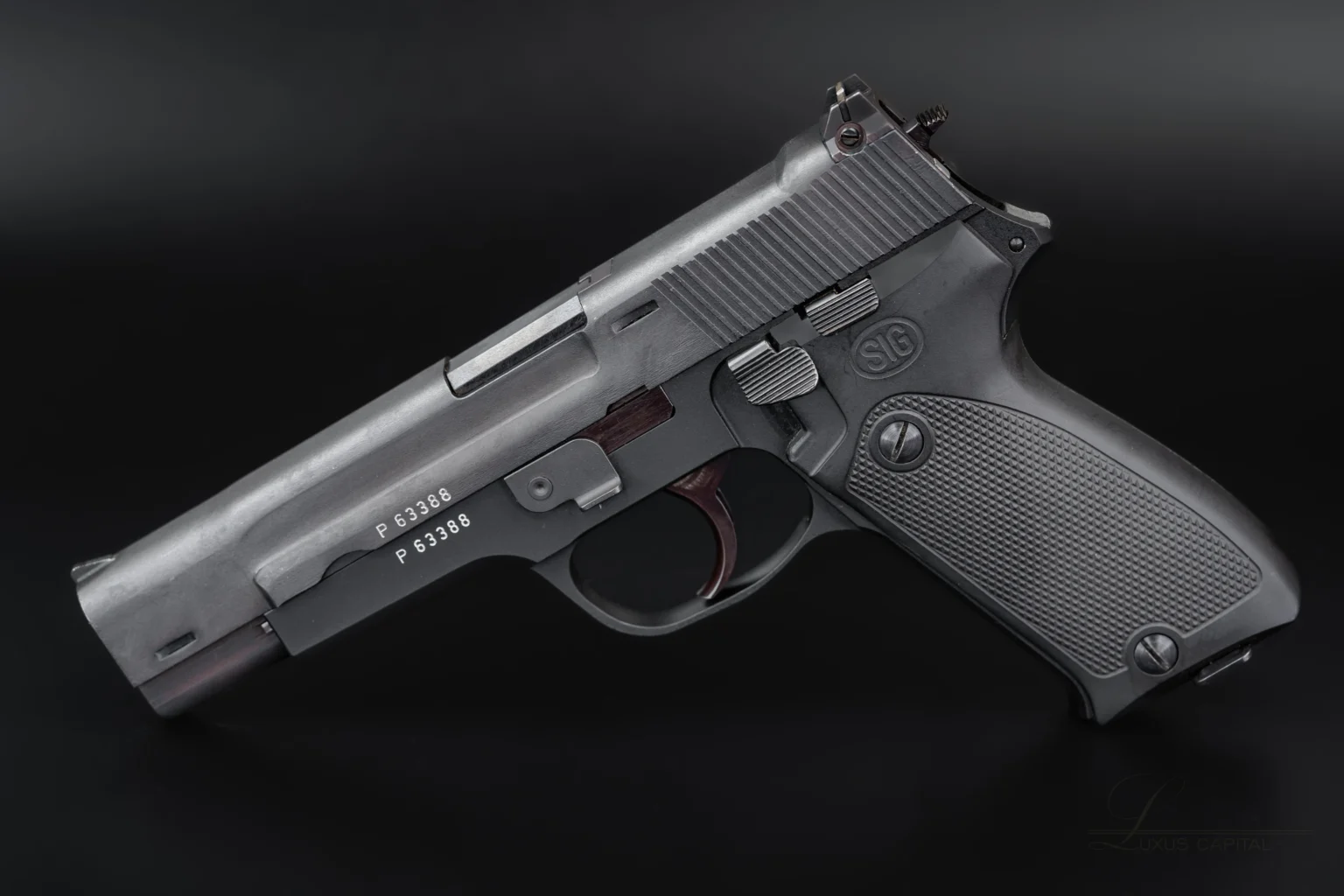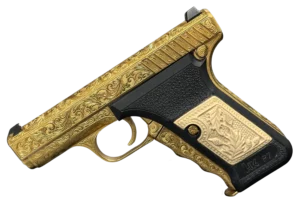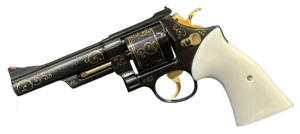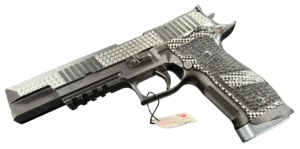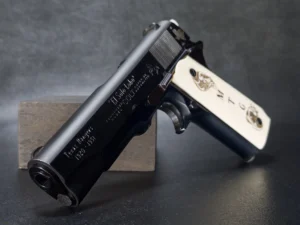Key Takeaways:
- The SIG Sauer P220 redefined what a modern service pistol could be: Born out of a need for practicality and reliability, the P220 replaced the costly SIG P210 without sacrificing accuracy. Its introduction of the DA/SA trigger and decocking lever wasn’t just clever—it shaped the direction of modern sidearm design.
- Its versatility and performance helped it earn a global reputation: From the Swiss Army to the Japan Self-Defense Forces, and even the Vatican’s Swiss Guard, the P220 proved itself in real-world conditions. Whether as a full-size duty pistol or a compact carry model, its performance stayed consistent.
- Decades later, the P220 still holds its ground on ranges, in collections, and on screen: With variants like the Elite, Legion, and Match models, the P220 continues to evolve while staying true to its roots. It’s not just a legacy piece; it’s a living, breathing icon that still competes, performs, and commands respect.
Some firearms serve a practical function, while others define an era. The SIG Sauer P220 falls into the latter category. It’s not just a handgun; it’s a landmark of design, a blend of Swiss engineering discipline and German manufacturing muscle. For anyone who cares about reliability, accuracy, or just plain brilliant mechanics, the P220 demands a closer look.
So, where did this iconic sidearm come from? And how did it go from a military replacement to a civilian favorite and international standard? That’s precisely what we’re about to explore.
A Replacement That Rewrote the Rules
Back in the 1970s, the Swiss Army found itself at a crossroads. Their long-trusted SIG P210—a beautifully crafted, pinpoint-accurate sidearm—was becoming too expensive and slow to build in large numbers. It was a hand-fitted masterpiece, yes, but not a practical option for modern military scaling.
Enter the SIG P220. Introduced in 1975, it was designed as a cost-effective and more user-friendly alternative. But don’t mistake “cost-effective” for “cheap.” This pistol maintained Swiss precision while increasing production speed and simplifying maintenance. With a new DA/SA trigger and a decocking lever—a novelty at the time—the P220 made shooting safer and faster.
And the results? Immediate success. The Swiss Army signed on, and soon, so did militaries and police forces worldwide. It didn’t take long for this gun to prove that it was more than just a follow-up act.
The Evolution of a Workhorse
The original P220 was chambered in 9mm and built for severe duty. It had that signature high bore axis, solid slide, and serious reliability. But like any great platform, it didn’t stay frozen in time.
Over the years, SIG Sauer expanded the P220 family to include a wide variety of calibers and configurations:
- Standard 9mm and .45 ACP versions
- The stainless steel P220ST for those who wanted a little extra heft
- Compact and Carry models
- Tactical editions with threaded barrels and Picatinny rails
- Elite and Legion series with all the modern bells and whistles
Each iteration carried the same P220 DNA but catered to different shooters—from duty professionals to weekend competitors to concealed carriers.
Looking Back: The P210 That Started It All
To understand the P220, it is helpful to rewind to its predecessor, the SIG P210. That pistol had a reputation for being ridiculously accurate and built like a Swiss watch. But here’s the thing—Swiss watches aren’t mass-produced for war.
The P210 was single-action only. You had to manually cock the hammer for the first shot. Not ideal in a high-stress combat scenario. It was also hand-fitted to perfection, which made production both slow and expensive.
The P220, in contrast, was a streamlined answer. Same philosophy of accuracy and quality, but with a modern DA/SA system and more straightforward production process. It wasn’t a compromise—it was a clever redesign for the real world.
The Decocker: Small Lever, Big Impact
One of the most talked-about features on the original P220 was its decocking lever. At the time, this was a groundbreaking development. Instead of manually lowering the hammer (which always feels like a gamble), the decocker let you safely transition from cocked to safe mode in one motion.
It became a signature feature for SIG, and one that would inspire similar systems across the industry. Safety and simplicity—not a bad combo.
Around the World: Who Carried the P220?
Plenty of nations saw the appeal. Besides the Swiss Army, Japan’s Self-Defense Forces chose the P220—a rare instance of Japan adopting a foreign sidearm. That speaks volumes about trust in this design.
And fun fact: for a short stint in the U.S., the P220 was sold as the Browning BDA. Same internals, different branding. Shooters figured it out quickly, though, and the P220 built a strong reputation in the United States.
It’s also been used by the Vatican’s Swiss Guard. That’s right—the guys who protect the Pope trusted the P220. That should tell you something.
Collectors, Shooters, and the P220 Family Tree
SIG Sauer didn’t stop at the basic model. They created a lineup that offered something for everyone:
- P220 Sport & Match Models – Extended barrels, target sights, precision-tuned for competitions.
- P220 Combat – FDE finish, threaded barrel, designed for tactical operations.
- P220 Carry & Compact – Shorter barrel and frame, better suited for concealed carry without sacrificing too much performance.
- P220ST – All stainless steel construction, for shooters who appreciate a solid, weighty feel.
- Elite & Legion Series – The top-tier editions. Think custom grips, night sights, beavertail frames, SIG flexing everything they’ve learned over the years.
Every variant added a layer to the P220’s legacy, and many of them are prized by collectors today.
Built to Run: Reliability Under Pressure
Here’s the thing about the P220: it just doesn’t quit. Whether it’s mud, water, or sand, this pistol has powered through some brutal torture tests. One fierce run involved thousands of rounds, no cleaning, and no stoppages. That kind of reliability earns a following.
Its fixed barrel design and locked breech system play a significant role in that consistency. Add to that a clean, predictable trigger pull, and you’ve got a pistol that feels as good to shoot as it does to depend on.
Competition-Ready (Even When It Wasn’t Meant To Be)
Although the P220 wasn’t initially built for the competition circuit, it ended up there anyway. Shooters appreciated the weight, the smooth double-action/single-action (DA/SA) action, and the tight groups it produced. SIG embraced that with the Match and Sport models, and suddenly the P220 had a second career as a target shooter’s best friend.
Even today, you can still see them attending matches. It’s not always about having the newest optics or the lightest polymer frame. Sometimes, performance speaks for itself.
A Star On Screen (And On Your Console)
Like many iconic guns, the P220 found its way into popular culture. Whether in films or video games, it’s often chosen to represent power and reliability. And let’s be real—there’s something about that slide profile and two-tone finish that looks cool on screen.
Gamers and movie buffs alike have probably seen it more than they realize. Its understated presence makes it a solid pick when creators want realism over flash.
Still Relevant After All These Years
You might expect a gun from the 1970s to fade quietly into retirement. The P220 didn’t get that memo.
SIG Sauer continues to produce and update the platform, bringing it into the 21st century with modern metallurgy, finishes, and ergonomic tweaks. You’ll find P220 models today with features the original designers couldn’t have imagined—and yet, it all still feels very true to the core idea.
Influence You Can Measure
The P220 has cast a long shadow. Its decocking system and modular approach to design have inspired entire product lines—not just from SIG, but from other gunmakers as well. The transition from single-action to double-action/single-action (DA/SA) triggers in service pistols? Yeah, you can thank the P220 for helping make that a trend.
It’s the blueprint behind much of what we now take for granted in modern sidearms.
For the Collectors: Why It Matters
For collectors, early P220 models are gems. Those original folded-slide versions, early Browning BDAs, and even well-worn military service pieces carry both historical value and practical shootability.
Some collect for investment. Others for nostalgia. And a few love the feel of that classic hammer drop. Whatever the reason, the P220 has no shortage of fans.
Final Thoughts: The Pistol That Set the Standard
So, what do we make of the SIG Sauer P220?
It’s not the flashiest gun in the world. It doesn’t chase trends. What it does do is show up—every time, in every condition, with just the right amount of old-school charm and modern capability.
Whether you’re a competitive shooter, a history nerd, a law enforcement vet, or just someone who appreciates sound engineering, the P220 has something to offer. It bridges generations. It built a legacy. And decades later, it’s still not done making its mark.
In a word? Classic.
Frequently Asked Questions
It’s not just one thing—it’s the total package. The P220 introduced several game-changing features for its time, like the DA/SA trigger system and decocking lever. Add Swiss precision, German engineering, and decades of proven performance, and you’ve got a handgun that earned its stripes the hard way.
While it has some old-school DNA, SIG has continuously updated the P220 line with modern materials, improved ergonomics, and optional upgrades such as night sights and Picatinny rails. Whether you’re carrying it or competing, it still delivers.
Originally chambered in 9mm, the P220 lineup expanded to include .45 ACP, .38 Super, and even 10mm in select variants. The .45 ACP version is probably the most well-known in the U.S., but all options bring that same smooth action and solid feel.
Great question—they’re both iconic, but serve different preferences. The P226 is a double-stack 9mm with a larger capacity, while the P220 typically runs single-stack in .45 ACP or 9mm. Think of the P220 as the refined heavyweight and the P226 as the high-capacity workhorse.
Surprisingly so. With regular maintenance, many early P220s still run like champs. Some collectors even shoot them regularly, especially those stainless models that seem to shrug off years of use.


